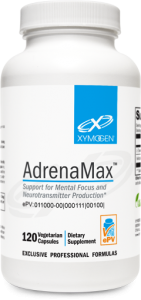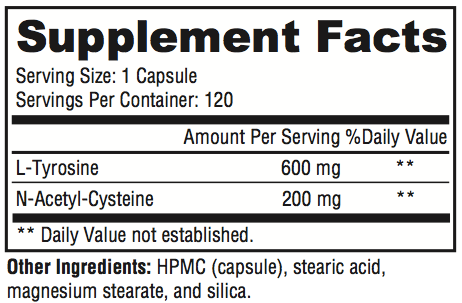AdrenaMax

Stress conditions, such as a cold environment, psychological stress, sleep deprivation, and strenuous, prolonged athletic activity, appear to reduce the body’s ability to convert phenylalanine to tyrosine. This underproduction may manifest itself as poor memory and performance. Tyrosine, as a precursor for catecholamine synthesis, presumably augments brain catecholamine levels and improves working memory under stress. Tyrosine also supports adrenal and pituitary function, and may increase thyroid hormone. Additionally, it is necessary for production of the skin pigment, melanin. Oral contraceptives may cause a decline in tyrosine plasma levels, possibly because estrogen can increase glucocorticoid levels. This, in turn, elevates levels of tyrosine aminotransferase, which degrades tyrosine in the liver.
Although increased dopamine may be beneficial in some circumstances, excessive synthesis of this neurotransmitter generates hydoxy radicals that stress glutathione levels. N-acetyl cysteine (NAC), a derivative of the amino acid, L-cysteine, is the precursor to glutathione and helps augment the body’s reserve of this important antioxidant. It has been included in this formula primarily to protect the neurons against dopamine toxicity. However, NAC also lessens the load on the methylation cycle, thereby decreasing the load on the THB cycle and promoting the conversion of tyrosine to dopamine.
Only a percentage of the tyrosine consumed will make it into the brain for conversion to catecholamines. The rest will be picked up for structural protein usage, etc. The only component that needs to be balanced with a glutathione precursor is the portion of tyrosine that is converted into catecholamines. For this reason, less NAC than tyrosine is present.
Directions
Start with 1 capsule twice daily. Increase to 2 capsules twice daily after 3-4 days if no improvement. You may increase to 3 capsules twice daily in the same manner.
References
- Growdon JH. Effects of oral L-tyrosine administration on CSF tyrosine and homovanillic acid levels in patients with Parkinson’s disease. Life Sci. 1982 Mar 8;30(10):827-32. [PMID: 6175872]
- O’Brien C, et al. Dietary tyrosine benefits cognitive and psychomotor performance during body cooling. Physiol Behav. 2007 Feb 28;90(2- 3):301-7. Epub 2006 Oct 31. [PMID: 17078981]
- Palinkas LA. Mental and cognitive performance in the cold. Int J Circumpolar Health. 2001 Aug;60(3):430-9. [PMID: 11590885]
- Deijen JB, Orlebeke JF. Effect of tyrosine on cognitive function and blood pressure under stress. Brain Res Bull. 1994;33(3):319-23. [PMID: 8293316]
- Magill RA, et al. Effects of tyrosine, phentermine, caffeine D-amphetamine, and placebo on cognitive and motor performance deficits during sleep deprivation. Nutr Neurosci. 2003 Aug;6(4):237-46. [PMID: 12887140]
- Rose DP, Cramp DG. Reduction of Plasma Tyrosine by Oral Contraceptives and Oestrogens: A Possible Consequence of Tyrosine Aminotransferase Induction, Clin Chim Acta, 1970;29:49-53. [PMID: 5500691]
- Lee M, et al. Effects of hydrogen sulfide-releasing L-DOPA derivatives on glial activation: potential for treating Parkinson’s disease. Biol Chem. 2010 Jun 4;285(23):17318-28. Epub 2010 Apr 5. [PMID: 20368333]
- Clark J, et al. Oral N-acetyl-cysteine attenuates loss of dopaminergic terminals in alpha-synuclein overexpressing mice. PLoS One. 2010 Aug 23;5(8). pii: e12333.[PMID: 20808797]








